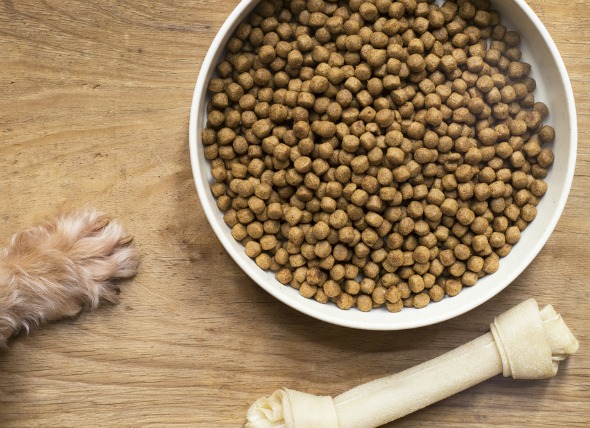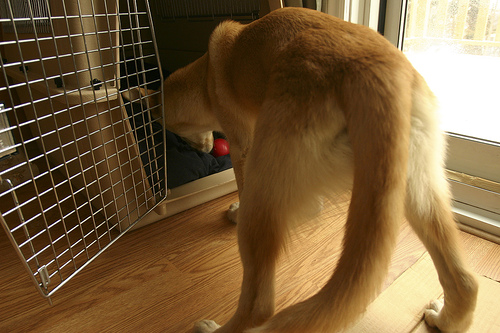

By Patricia Khuly, DVM
Originally published as a three-part series on Fully Vetted.
Do you switch your pet’s food around? Be honest. Assuming you feed commercial, do you succumb to whatever super-premium canned kitty food is on sale this week? Is it one month Halo, next month Canidae? If so … you shouldn’t feel so bad about it (prevailing veterinary sentiment notwithstanding).
Yes, veterinarians can be kind of funny on this topic. Get us chatting on the subject of pet foods and you’ll find we tend towards the conservative. So, too, does it go on the subject of switching pet foods.
For example, when asked if the occasional food switcheroo might be OK, most vets will offer up their best frowny face and lace their next few sentences with ominous gastrointestinal details involving the words "bowels," "gut," and "microflora" — none of which sound too promising with respect to your pet’s potential diet change.
So you know, we vets tend to cop this cautionary attitude for one understandable (if sometimes paranoid) reason: The vast majority of our gastroenteritis cases revolve around pets whose diets were suddenly changed. Hence, our profound and persistent distrust of pet owners when it comes to messing with our patients’ diets. Because it sucks to have to hospitalize a patient for three days after her three-year-long love affair with lamb and rice ended in a venison and potato-ey pool of bloody diarrhea.
Yet if we’re honest with ourselves, veterinarians might admit we bear some responsibility for the kind of confusion that leads to multiple mud-piles in the living room a day or two after a big switch. After all, our profession’s reliance on commercial pet foods as the end-all-be-all of our patients’ diets has contributed mightily to a dearth of common sense on the subject of pet food in general — and food changes in particular.
Here’s how I see it:
There’s no doubt that the advent of nutritionally balanced pet foods (beginning in the 1950s and ‘60s) made pet-keeping doable en masse — convenient, even. It’s also true that a great many pets would still be suffering nutritional diseases if these pet foods were not inexpensive and readily accessible.
However, the way the pet food industry evolved, the "one bag for life" concept became the accepted mantra. (Madison Avenue might've had something to do with it.) So, too, did veterinarians latch readily onto the concept, citing the pet food industry’s "proof-of-life" testing (i.e., proving a pet's reasonable longevity on one-formula alone). Sure, it’s a low bar. A beagle’s ten to fourteen years' survival rests on one bottomless bag of food. But all of us tacitly accepted this as a good-enough metric at some point. Indeed, many of us still do.
Fast-forward to today’s take on pet foods and the heightened dedication of the average pet owner — not to mention our cultural emphasis on nutrition and the proliferation of brands — which has gotten lots of us to thinking our past pets may not have had it so great. Maybe we should have been mixing it up all along, we posited. Problem is, when we finally did take the plunge and tried that pretty new bag of Nulo or ordered a shipment from Honest Kitchen, some of us inevitably did a double-take when we experienced what the new food bought to us.
In too many cases, a malodorous mess urged owners to go back to Beneful and leave well enough alone. Our veterinarian’s "I told you so" after the rapid-switching trick often sealed it. And yet, we know changing foods doesn’t have to be all gloom and doom. This we know from our own human experience as modern omnivores, right?
There's obviously much more to this food-switching issue than meets the eye.
Here’s how I see it:
If variety is a virtue when it comes to nutrition, it stands to reason that the one-formula-for-life approach might be problematic for our pets. One kind of food, it would seem, is unlikely to meet all of the needs a complex organism (such as our pet) would require over a lifetime.
Nonetheless, pet food manufacturers have gone to great lengths to devise formulas that are "100% nutritionally balanced" to best meet the needs of dogs and cats. Decades of research and multiple pet lifetimes of testing have gone into the majority of these foods. Formulas are revised and refined constantly.
The problem is this: If we’ve undertaken thousands of times more research on human nutrition and still can’t decide what’s best for us, does it not stand to reason that a "nutritionally balanced" diet for our pets might elude modern science as well?
It’s for this primary reason that I recommend the occasional formula change.
It’s not much to do with my nutrition schooling, really; rather, it's just one of those commonsensical deductions I’d like to think of as fundamental. And yet, I’ve been roundly criticized by some colleagues for taking this position.
Given the lack of evidence to support the benefit of formula variety for optimum nutrition and the preponderance of evidence for their digestive drawbacks, they say, my recommendations smack of irresponsibility. (Raw feeders: Does this argument sound familiar?) Nonetheless, I stand by the reasonable assumption that variety is a good thing.
But let’s say you’re still sitting with my detractors on this one. Even so, can we not all agree that there are very good reasons to undertake dietary changes?
Indeed, veterinarians are often the first to recommend you offer new foods, as in the case of therapeutic diets, food trials for skin allergies, and intolerances.
To that end, here’s my list of the top ten reasons a diet change might prove worthwhile, necessary and/or unavoidable:
1. Variety (I repeat myself).
2. Food allergies that manifest in the skin (reportedly the third most common skin disease in dogs and cats).
3. Non-cutaneous food allergies (as when the body’s immune system overreacts to a normal food, as with gastrointestinal disorders like inflammatory bowel disease).
4. Food intolerances/sensitivities (these have a non-immune basis, as with lactose intolerance in humans in which we lack a basic enzyme).
5. Gastrointestinal motility disorders (as with megaesophagus, among other not-uncommon conditions).
6. Chronic illnesses (think: renal failure, urinary stones, liver disease, heart disease, and geriatric conditions).
7. Food recalls and formula changes (they can and do happen).
8. Hurricanes, earthquakes, tornadoes, Costco closing early, and other acts of God (they can and do happen, too).
9. Because you don’t want a pet so gastrointestinally wedded to any one formula that any deviation from it leads to a lake of fetid, mucoid goo (guest-feeding and garbage-eating do happen, you know).
10. Because how can you honestly say, "My pet eats "X" and he’s always done great!" unless you have something to compare it to?
Note that I did not include: "Because he gets bored of his food and refuses to eat." While this may indeed play a role for some animals, I have a hard time believing that the vast majority of animals are not simply playing their people for better fare. (Indeed, most of my patients who suffer "chronic finickiness" are overweight or obese. Explain that.)
OK, so now that we’re done with why, we can move on to how.
Feeling ready to start mixing it up? If I, your veterinarian, or some other reasonably trustworthy resource have convinced you that you might want to play around with your pets’ diet, here's the post that should help you avoid any pitfalls.
For this I can only offer you my simplest recipes for success. Here’s my thoroughly unpatentable five step process for switching pet foods:
(This one assumes you’ll be feeding commercial pet foods. Nonetheless, I’ll bet those who don’t might also find some timeless gems here.)
This is for the true first-timer pet. The first time you undertake a diet change, as when you find a pet on the street and you don’t know what he’s ever eaten before, try offering what I call a "bland diet."
For dogs, I mix the brand of dog food I plan to introduce along with an equal volume of starchy food (rice, potatoes, oatmeal, etc.). Initially, I keep the volume small (about half what I think they might need). I wait 12 hours and if no untoward GI (gastrointestinal) accidents have befallen us, I plow ahead and increase the amount to a more normal volume of 1/2 dog food, 1/2 starchy stuff.
Alternatively, trying a 1-to-5 combo of meat to starch for a day or two before mixing in some commercial food is also a good way to go, especially if you meet with gastrointestinal resistance on the first commercial try.
Over the next three to five days (seven or more days for those whose stool seems softer than it probably should be), gradually increase the amount of commercial food, decreasing the extra starch as you go.
For cats, I tend to use a prescription diet for intestinal sensitivity since most cats don’t take rice with their cat food. Still, I’ve found that hungry cats will eat pumpkin or puréed peas with their commercial cat food, or a chicken and rice baby food diet. (Libby’s canned pumpkin is a fave of mine. I always buy a bunch after the holidays since it’s usually half price.)
As long as the cat's stool stays nice and normal, I’ll slowly add in more of the standard commercial fare; usually over 3 to 5 days.
The most common method I’ve always ascribed to is pretty simple. It’s the one-quarter, one-half, three-quarters method.
Day 1: 1/4 new food, 3/4 old
Day 2: 1/2 new food, 1/2 old
Day 3: 3/4 new food, 1/4 old
By day four — voilá! — you’re on the new diet. This works for most pets, but some require extra tinkering (read: a longer transition period). This usually depends on a couple of factors: 1) Your pet’s GI sensitivity (you get a handle on this pretty quickly after a couple of changes); and 2) the degree of difference between the diets involved.
This happens. Recalls, hurricanes, earthquakes, surgery and other misfortunes will befall us all at some point, whether we’re ready for them or not. These cataclysmic(ish) events mean that from one day to the next we may face a strict diet change. In these cases, simply reference Step 1.
If you keep enough pets over your lifetime, I promise you will run into at least one animal whose health demands that you play the pet food field. Being systematic is the way to go. For example, I tend to have my clients stick to a monthly diet change if they’re on a mission to find the one right food for any given gastrointestinal condition (i.e., a new food every month). For skin conditions it’s more like every three months (refer to my food trials post for more info).
Of course, a monthly or twelve week-long course may not work out. Sometimes foods are obviously problematic from the get go. Or the size of the bag, case or shipment doesn’t always match up exactly. Still, it’s a rule of thumb.
Round robin starts to look a whole lot more like whack-a-mole if you don’t keep track of what you are feeding your dog or cat. As you make the changes, write down when you feed your pet and what your pet’s health is like while you’re feeding it. This makes a whole lot of sense, right?
My solution: Start keeping a feeding diary. It need be nothing more than one sheet taped to the inside of the pantry door or a few pages in a spiral bound memo pad. Nothing fancy, but you really should keep track. So that if something goes awry you know where in the process it happened.
***
My work here is done. The rest is up to you. Have any tips or tricks you’d like to offer? Give ‘em up ...
 Kidney Failure in Dogs
Kidney failure has it origins in a wide variety of
Kidney Failure in Dogs
Kidney failure has it origins in a wide variety of
 Canine Positive Portable Kennel Training
This article is courtesy of The Hannah Society.
&
Canine Positive Portable Kennel Training
This article is courtesy of The Hannah Society.
&
 10 Halloween Safety Tips for Pets
No Scaredy-Cats Allowed
Halloween can be a
10 Halloween Safety Tips for Pets
No Scaredy-Cats Allowed
Halloween can be a
 Dancing with Your Dog
Maybe you have a dog that loves to move around t
Dancing with Your Dog
Maybe you have a dog that loves to move around t
 Caring for Your Pet’s Skin During the Winter Season
By the time we reach adulthood, most of us have d
Caring for Your Pet’s Skin During the Winter Season
By the time we reach adulthood, most of us have d
Copyright © 2005-2016 Pet Information All Rights Reserved
Contact us: www162date@outlook.com